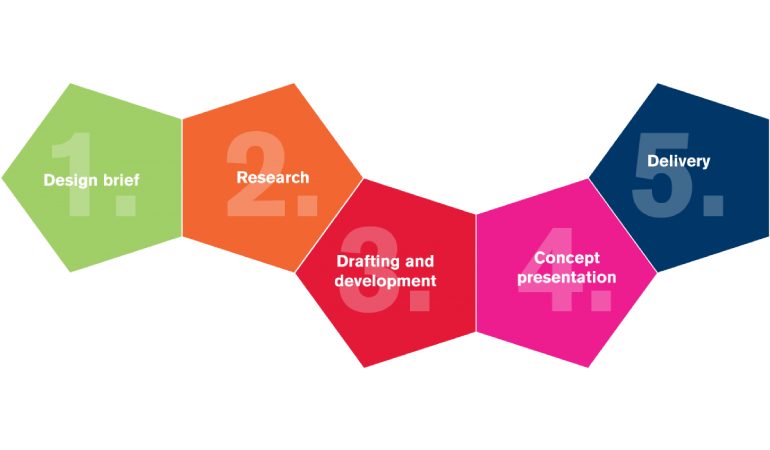Steps that can be used to develop a great logo
This article describes seven steps that can be used to develop a great logo. These are time tested steps that have been used in the development of some of the worlds most memorable logos.
Seven Steps to Developing a Great Logo
1) Make it Memorable
There are two primary purposes for a logo. One is to identify an entity (e.g., corporate, government or social organization). The other is to identify a product or service. In the best case scenario, when you see the logo, that entity, product or service should come to mind. So really nothing is more important to the development of a successful logo design than it being memorable. To that end the main graphical image of a logo, without any additional text or visual cues, should be sufficient to conjure the entity, product or service. You shouldn’t have to read the fine print to distinguish between an insurance company’s logo and one for a bottle of water.
There are several tools that can be used to make a logo memorable. One common tool is humor. Humor can indeed be a very powerful mental cue. We remember things that make us smile. Depending on what the logo is for, humor can be used very appropriately. I will elaborate on this later.
Repetition is another tool that can make a logo memorable. Think back to grade school spelling. One of the ways you remembered how to spell a word was spelling it out loud over and over again. Repetition can also mean using items in a memorable sequence. For example AAA is more memorable that AMO. 010101 is more memorable that 011100. This same principle can be applied visually.
The thing to remember when trying to make a logo memorable is to make sure it is remembered for the right reasons. It should be remembered as being positive and appropriate for the product or service.
2) Describable
A logo being describable goes hand and hand with it being memorable. Anything that is easy to remember is usually pretty easy to describe. So taking that statement one step further means that in order for a logo to be describable it has to be simple, because the simpler it is , the easier it is to remember. If you think about it, most of the really memorable logos are pretty simple and easily described.
Here’s a simple illustration of this principle. The world’s oldest registered logo is a red triangle. Now what could be simpler than that? If someone says red triangle, there is no need for further explanation. It is what it is. Even if you don’t know what product or service the red triangle represents, you can visualize the logo. The logo happens to be that of Bass Ale. To illustrate the point further, let us say you’re laid up with a broken leg, so you send your dear old mom on a little errand. You say “Mom, could you pick up a six pack of Bass Ale for me?” Of course your mom has no idea what that is. You say “Mom, just get the one that has the red triangle on it”. The chances are pretty good that even with dear old mom’s failing memory, that simple description will be enough to ensure that she’ll come back with Bass Ale.
3) Unique
For obvious reasons, a logo has to be unique. If it doesn’t stand out from the rest, what’s the point? As it is with being memorable though, it has to be unique in a good way. There are plenty of things that are unique that you want absolutely nothing to do with. The scent of a skunk for instance or a ’74 AMC Matador (widely considered the ugliest car ever to come off an assembly line).
A great logo might stand apart from the crowd for any number of good reasons. Boldness, elegance, simplicity. The tricky thing is that a design element that makes one logo stand apart (in a good way) might come across as forced or even silly if used as an element in another logo. The property of uniqueness has to be appropriate to the product or service. You wouldn’t want a logo that reeks of elegance when what really should be implied is a sense of ruggedness.
4) Positive and Negative Space
Most of the great logos over the past hundred years or so have all had one thing in common. That is a really good use of positive and negative space. When we talk about the relationship between positive and negative space, what we’re really talking about is balance. Most things in nature and life for that matter require balance or they just don’t work. The concept that nature abhors a vacuum is really about the fact that nature insists that there is always balance. The natural word simply won’t accept less. Design in that way is much like nature. Good design requires a type of balance and simply can’t exist without it. That balance is achieved by the proper use of positive and negative space.
OK, so design like nature requires a type of balance. Why should that determine what my logo looks like? Well, because even with all our technology we are still creatures of nature. Our minds simply don’t handle visual cues that or unnatural very well. Our brain doesn’t necessarily reject them the way nature reject’s a vacuum, but it does find them uncomfortable. Discomfort is probably not the feeling that most people are looking for in a logo.
5) Scalable
In order to be functional, a logo has to work at any size. A logo might be designed with a specific application in mind, like a t-shirt or a coffee mug, but you never know when or where a logo may end up. For that reason a logo has to be designed to be just as effective on the side of a plane as it is on a letterhead. Enlarging a logo is usually not an issue, but special care must be taken when the final usage of logo might be tiny. Some rules of thumb to remember are: a) Avoid really thin lines in a logo. They may bleed together or disappear entirely when a logo is reduced in size. b) Simple images will reduce more easily. Think of the head of a penny viewed at one quarter actual size vs. a dollar bill view at one quarter size. Even though both would still be recognizable, the simpler penny retains more of its original design features. c) Colors that are close in hew and shade will be hard to distinguish between when a logo is viewed at a small size. Conversely colors that contrast are easier for the eye to separate when viewed small. d) Avoid shadow effects as an integral part of a logo design. They don’t reduce well.
6) Logical and Straightforward
A logo design works best if a logical approach is used in its development. What’s logical? A logo should visually suggest what the product or services is or does. That is not to say that the logo should contain or be an illustration or picture of the product or service. A good example is this. If the name of a company has the word “red” in it, than it would be logical to use the color red in the design of the logo.
A logical approach to logo design also means that the primary elements of the logo should pertain directly to the entity, product or service. A logo should not be cluttered with a bunch of elements that are irrelevant to getting the message across. Often the approach that is simplest is also the one that is most logical.
7) Clever vs. Humorous
Earlier on I mentioned how humor as a tool that can be used to make a logo memorable.
Maybe humor is not quite the right word. What I’m really referring to could more accurately be described as cleverness. A logo isn’t a cartoon. It doesn’t need to be “Ha Ha” funny. It shouldn’t even necessarily elicit a smile. But clever is good. Clever is what causes the emotional response one has to a logo when they look at it and say “Oh, I get it”. Of course a verbal response isn’t what you’re looking for, but there should be a moment where that response happens in your mind, and not even necessarily on a conscious level.
Think for a second about the FedEx logo. It’s certainly one of the world’s most recognizable logos. At first glance, the logo is just 5 block letters. Some among us are perceptive enough to have seen the right facing arrow between the letters E and x the first time we viewed it. Many of us though only perceived the arrow (denoting motion, direction and speed) on a subliminal level. There may be no other logo that elicits such and emotional response on a subconscious level. Pretty clever, yes?
Be careful about making a logo too clever. Often an attempt at being clever can lead to imagery that’s cliché. You don’t want a logo that everyone “gets” because they’ve seen it a hundred times before. Remember a clever logo works best when the “Oh, I get it” moment is subtle.




